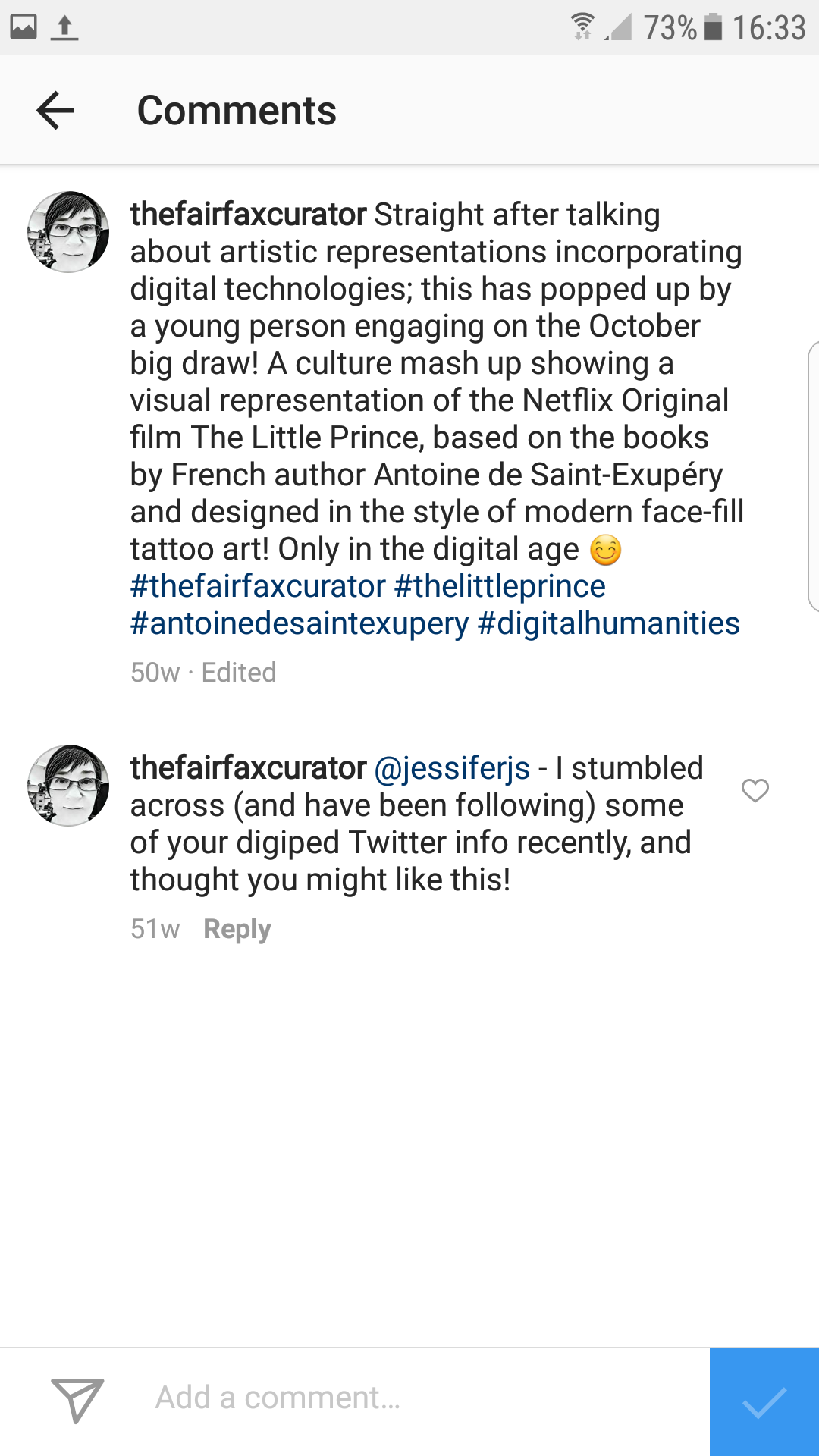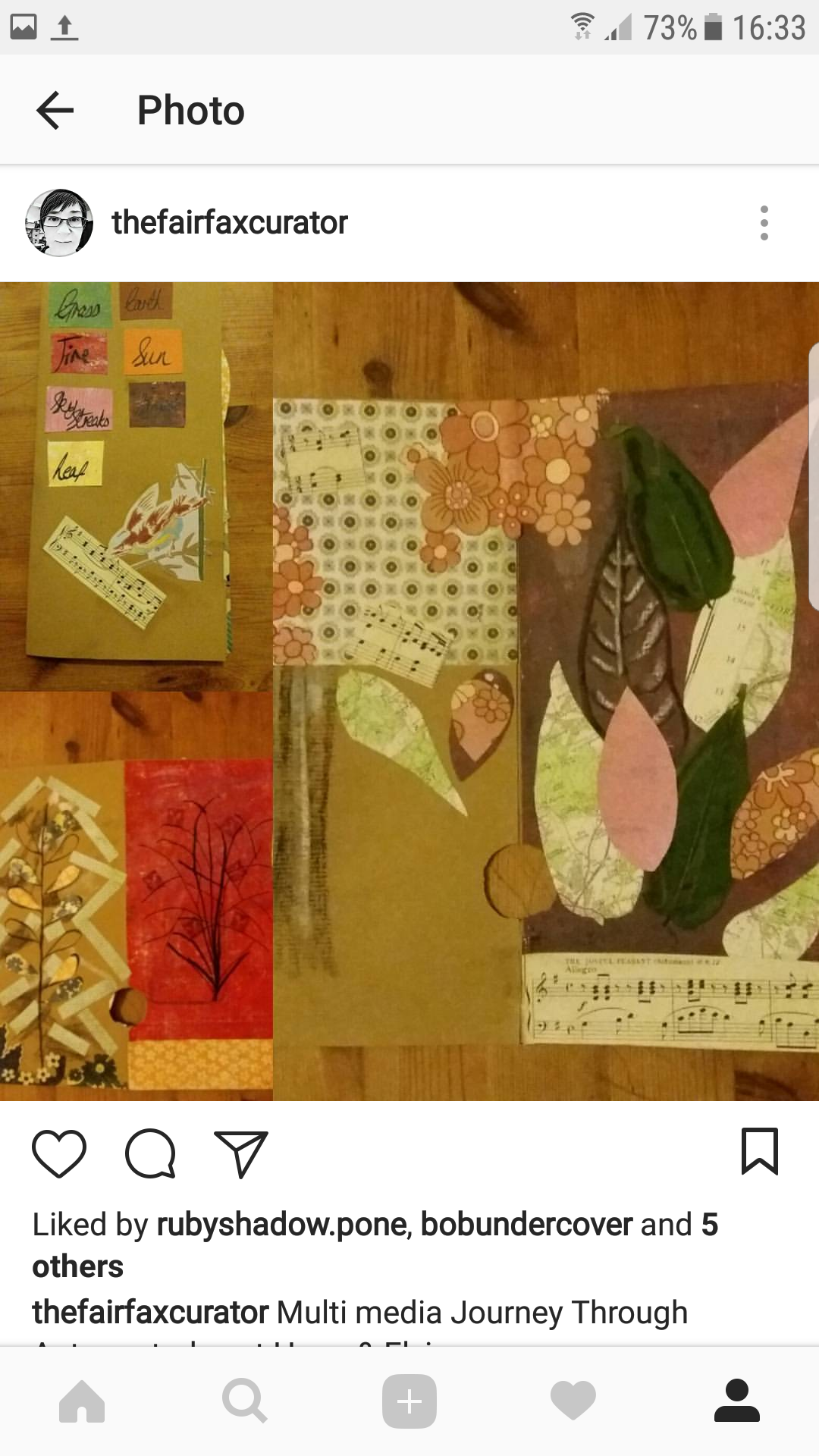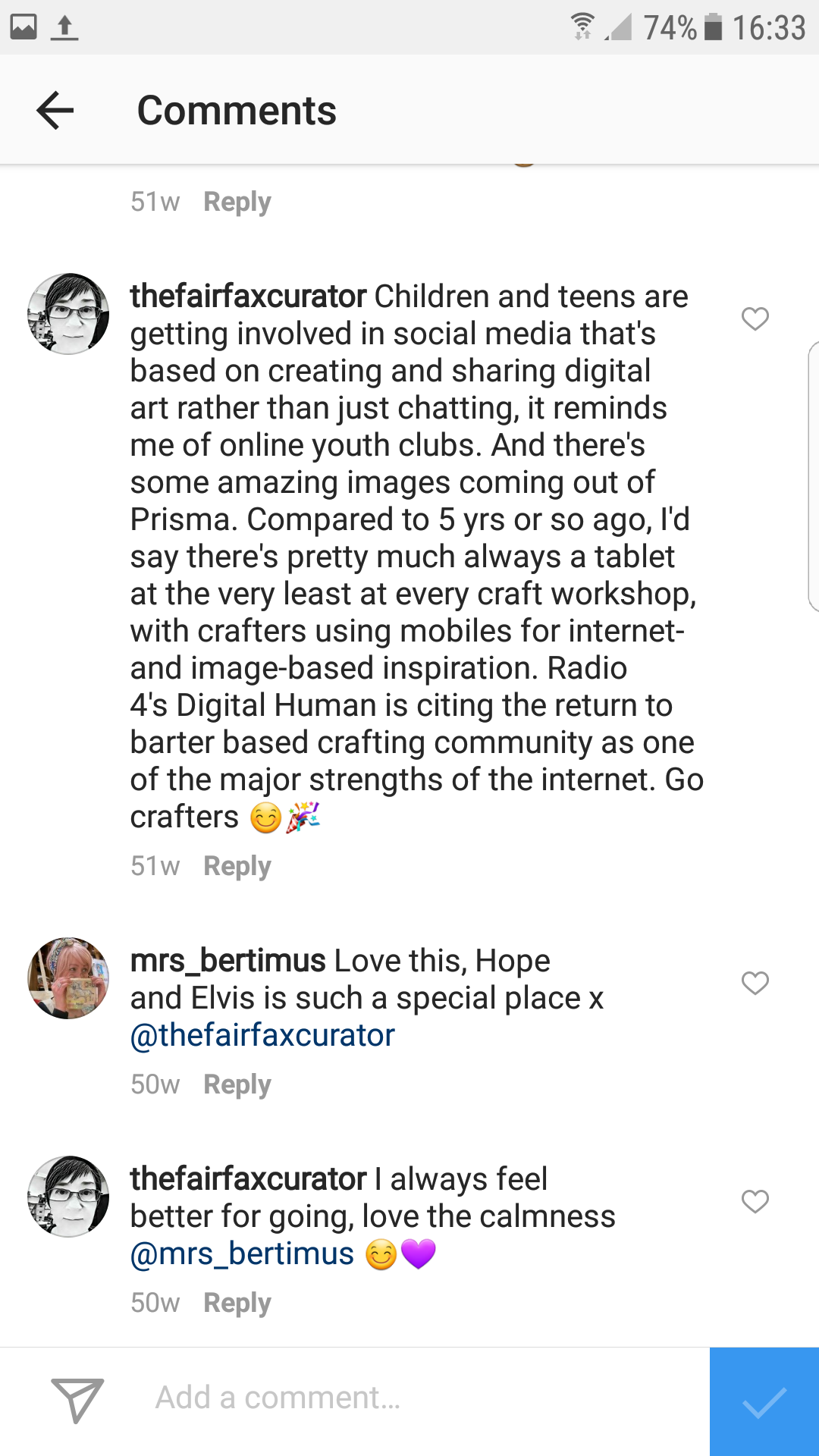
Network Participation
A documentary display of network participation displaying research into areas of digital media relevant to research topics. This piece spans the period from November 2016 to October 2017. This experiment had an academic brief to both consider and develop active participation in preferred research areas. The discussion shown here is the result of the active network participations.
Network Participation: 12AoC
Always developing my knowledge and research in digital pedagogy, in late November 2016 I expressed interest in, and was invited to join, an independent course that was designed both to increase the use of mobile applications in teaching and learning, and to analyse statistics to test the ongoing or changing usage of these applications. Teachers and academics were invited to join if in employment that facilitated use, and the course was free. It was based on the premise of '12 Apps of Christmas' (12AoC), and was intended to take no more than 10 minutes per day, for 12 consecutive days, on the run-up to the Christmas break 2016. This was only the second time that the course had run, with its inception year being 2015, but this is intended to continue year on year, and participants from previous courses access ongoing feedback.
1,365 academics and teachers eventually signed up to the course. This is an excerpt from the Day 2 email received by participants from the course leader, Chris Howell:
Email content from Chris Howell, lead researcher of 12 AoC:
Welcome to Day 2 of the 12 Apps of Christmas.
What an amazing first day we had yesterday – over 1100 enrolments - 676 posts on the discussion boards and fantastic discussions on Twitter!
By the end of the 12 days, the following apps had been tested by all active participants (including myself) with a view to their use within digital pedagogy:
Day 1: Kahoot, Day 2: Skitch/Sketch, Day 3: Lensoo Create, Day 4: Habitica, Day 5: Sway, Day 6: Snapchat, Day 7: Google Cardboard, Day 8: Book Creator, Day 9: Stop Motion Studio, Day 10: Voki, Day 11: ThingLink, Day 12: Elfster.
As part of the course, participants spent a suggested time of 10 minutes per day developing something the allocated application for that day, according to a specification for that day. Results were then shared with the rest of the course attendees through the BlackBoard forum page and through any other means of the participants' own choosing; many of my own test creations were shared through Twitter.
My Day 1 Kahoot quiz creation can be viewed here.
The Day 10 Voki terrible Christmas joke creation can be seen and heard here.
The Day 11 ThingLink I created can be viewed here. I developed this very basic creation with initial training in the field of digital learning and teaching in mind, and it therefore included an interactive colouring page, the general concept of which other participants felt could be made use of in their own classes.
My creations were shared further on Twitter, and became part of the 12AoC Twitter feed featuring mobile application updates and information with the wider digital pedagogy community, who have an active Twitter presence. The feed can be viewed at #12AoC on Twitter.
Final results of the 12AoC 2016 course were analysed, feedback investigated, and then shared on a Wordpress blog; the feedback report is available here. I was one of the participants who completed both the pre-course questionnaire and the end of course survey to support the results, I was also on the list of availability for videographic feedback on the course content when this is required. I will also receive updates on the 12AoC 2017 course when this is released, and intend to join this again when enrolment opens.
Results from the feedback report supply information on the three mobile applications most likely to be used again in teaching and learning, and statistics on the sign-up information of participants joining the course. Some of the feedback was surprising; for example, despite only representing 45% of the sector, female participants made up 75% of those joining the course, suggesting that women are more likely to participate in these development opportunities and share knowledge and information. 50% of respondents used Twitter on the course, compared to only 4% who used Facebook; the course leaders have taken this figure to suggest that Twitter remains the chosen academic platform for digital humanities.
ResearchGate: Profile Generation
During December 2016, my academic profile on ResearchGate was also developed. Rather than begin with a blank profile and project, I instead generated a DOI code for my degree thesis in order to show an academic piece that I had already completed. My degree dissertation, completed July 2007, was an archaeological investigation using digital means to generate links in evidence deposits; in line with easily accessible contemporary software, I built a Microsoft Access database to formally define excavation evidence as types; the thesis can be viewed here.
In early 2017, open projects were uploaded for the research that I had decided on as the strongest contenders for my personal preference areas. These were the development of literature-based video-gaming in the form of the art-house gaming genre, and the introduction of digital connectivity into the arts and crafts sector; particularly in terms of the barter-style interaction inherent in this sector. There is very little written research into these fields, and so supporting reference material can be difficult to access. I therefore initiated my research by asking the academic community for links to work, and so engaged with interested academics through answer and response.
The first question posed to the community was: "What are other researchers thoughts on the development of digital culture, and the impact of digital markets, in the arena of arts and crafts?". This interaction gained a thread discussion lasting six entries, and supplied twelve links to very recent research uploaded on academic sites such as ResearchGate and university websites on this topic. The relatively small response was not unexpected, and was appropriate for the unusual subject area. Indeed, this was actually a more thorough response than I had expected. The question and responses can be viewed here by ResearchGate account holders.
The second question asked was: "Does anyone know of any research that specifically considers the use of narrative in gaming, apart from that by Dr Dan Pinchbeck?". I expected this question to be similarly small in interest and scope, but had allowed that it may attract personal interest as well as subject scope. The actual response was a surprise; this interaction gained a thread discussion lasting twenty entries, and supplied a plethora of links, game examples, and a direct link to a narratologist investigating video-gaming that I intend to utilise during my second year of study. The question and responses can be viewed here by ResearchGate account holders.
Interest level in my area of study increased through responses to this question, and I further uploaded links to the ResearchGate project to my first (Digital Timeline) assignment conducted in this area. This has led to the achievement of eleven project views, and the sharing of my timeline through Twitter.
Association with the ResearchGate community has led to requests for responses in similar areas of research, and interactions have continued in the guise of responses to other researchers' questions relevant to my academic and economic field. In the course of the last year, I have responded to eleven research questions and have garnered five recommendations to other researchers; I also have nineteen academic followers. While these statistics are small, they are not insignificant in such a small, specialised area of research. I am still active in this area and intend to continue with my academic account.
Social Media: Sector Interaction
While a smaller area of definitive interaction than the previous two examples, social media has been a useful method of initiating interaction, and in staying updated in terms of further links, developments, and opportunities in all research areas. I tried a number of options initially, which gradually diminished into those options that I found most successful for remaining up to date. In addition to these options, I also found there was no real alternative to actual attendance at sector functions, and therefore attended the gaming convention EGX 2017 at Birmingham NEC, where it was possible to directly comment on subjects such as independent game development.
My final chosen social media options were a Pearltrees account, an Instagram account, a Twitter account, and a personal Facebook blog. Originally starting on WordPress, I moved the blog to Facebook after finding it easier to link to Twitter and Instagram. Of my three chosen options, this is the least interactive, and I mainly update it in order to show general participation with my chosen communities, and as a method of logging interactions in relevant social groups. For example, I am presently engaging in 'Inktober 2017' with many other members of the art community, and basic progress is logged on my Facebook blog through uploaded images.
My blog, accessible here, began as a method of introducing myself and my digital interests, wherein I wrote pieces about literature and digital cultures relevant to personal experience and travels. It was also the first introduction of my digital avatar, The Fairfax Curator. This was created for internet security whilst I tried out different communication methods, and I would certainly advise this as a way of differentiating between everyday interaction and internet-based activity. Once the avatar becomes well enough known through dedicated hash-tagging, it offers a way of naming a specific set of personal activity. Similarly, I have a specific gamer tag for use in gaming circles.
Whilst my blog is not heavily used presently, after it was first moved to Facebook, I was contacted by a former colleague who is an amateur vintage arts and crafts photographer to conduct a joint blog, in which my colleague would photograph the areas of interest and I would complete the write-up. I have agreed to look at initiating this at the closure of my present studies, and this communication area has the potential to grow over the next few years in response to this.
My Instagram account is mainly used to like and share photographs and videos from the digital humanities, arts and crafts, and gaming sectors. This method of interaction was most useful because my chosen research areas are very visual in concept; this is also the chosen social centre for arts and crafts. In terms of development, I used the Instagram account to assess initial interest in the integration of digital means in the arts and crafts sector, and received a positive response.
This response grew following attendance at a multimedia workshop in which podcasts were used to generate an overview of subject matter, showing that even areas in which digital tools are not a major factor, these are still being integrated for added value.
With a different utilisation than the other accounts, I use a heavily curated Twitter following mainly to stay updated on the work of people engaged in digital humanities. I use this option both to share completed work, and to gain a basic understanding of developments around the world. I particularly follow games designers, library developments such as those of the Welcome Library, whose work includes the restoration and sharing of the content of rare aged texts, and individuals such as Jesse Stommel, one of the leads in digital pedagogy, and Michael Goldfarb, a leading author and political writer. I also engage with present interests, such as the Digital Human and Team Human podcast releases. Finally I utilise Twitter in order to share completed work for comment and interaction; my Digital Timeline and Pearltrees Data Curation were both shared on Twitter as well as ResearchGate to attract comments and thoughts.
The image above shows that the retweet of my Digital Curation and interest from a small YouTube gaming channel led to the increased interest from groups involved in digital humanities. I accepted invites to several groups focusing on digital humanities and pedagogy following these shares.
Of all the mediums I have utilised, the Instagram and Twitter accounts are my most heavily curated. I have found that keeping my follow list small and tightly focused increases, rather than decreases, focused and beneficial interaction with the most appropriate groups. These are also the most pertinent means to access information on new developments, including those that are open-access, and can be joined by new subscribers interested in gaining a footing in the sector.







Harvard reference if accessing item for use:
Taylor, S. (2016). Network Participation. Sheffield: Squarespace. [Online]. Available from: www/fairfaxcuratorart/gaming-narratives-portfolio/network-participation [Accessed Date].







